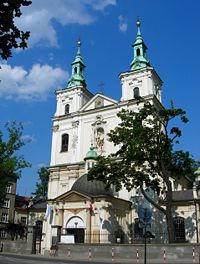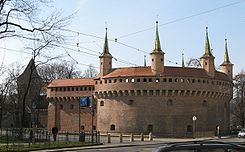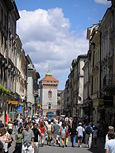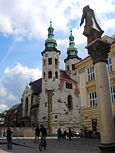
Royal Road, Kraków
Encyclopedia
royal-route.jpg)
Kraków
Kraków also Krakow, or Cracow , is the second largest and one of the oldest cities in Poland. Situated on the Vistula River in the Lesser Poland region, the city dates back to the 7th century. Kraków has traditionally been one of the leading centres of Polish academic, cultural, and artistic life...
, Poland
Poland
Poland , officially the Republic of Poland , is a country in Central Europe bordered by Germany to the west; the Czech Republic and Slovakia to the south; Ukraine, Belarus and Lithuania to the east; and the Baltic Sea and Kaliningrad Oblast, a Russian exclave, to the north...
, begins at the northern end of the medieval Old Town and continues south through the centre of town towards Wawel Hill
Wawel Hill
Wawel Hill is the name of a Jurassic limestone outcrop formed about 150 million years ago. It is situated on the left bank of the Vistula River in Kraków, Poland, at an altitude of 228 metres above the sea level. Over the millennia, the hill provided a safe haven for people who settled there since...
, where the old royal residence, Wawel Castle
Wawel Castle
The Gothic Wawel Castle in Kraków in Poland was built at the behest of Casimir III the Great and consists of a number of structures situated around the central courtyard. In the 14th century it was rebuilt by Jogaila and Jadwiga of Poland. Their reign saw the addition of the tower called the Hen's...
, is located. The Royal Road passes some of the most prominent historic landmarks of Poland's royal capital, providing a suitable background to coronation processions and parades, kings' and princes' receptions, foreign envoys and guests of distinction traveling from a far country to their destination at Wawel
Wawel
Wawel is an architectural complex erected over many centuries atop a limestone outcrop on the left bank of the Vistula River in Kraków, Poland, at an altitude of 228 metres above the sea level. It is a place of great significance to the Polish people. The Royal Castle with an armoury and the...
.
The Royal Road starts outside the northern flank of the old city walls in the medieval suburb of Kleparz, now a central district of Kraków. It begins at St. Florian's Church
St. Florian's Church
The Collegiate Church of St. Florian is a historic church in Kraków, Poland. It stands at the northern end of Matejko Square and the former centre of the mediaeval city of Kleparz, now a district of Kraków. The edifice marks the beginning of the Royal Road....
(Kościół św. Floriana), containing the relics of St. Florian – the Patron Saint of Poland – miraculously saved numerous times in the 12th, 16th and 17th centuries. St. Florian's Church was also the starting point for royal funeral procession
Funeral procession
A funeral procession is a procession, usually in motor vehicles, from a church, synagogue, or mosque to the cemetery. The deceased is usually transported in a hearse, while family and friends follow in their vehicles.- Standard procedure :...
s, concluding at Wawel Cathedral
Wawel Cathedral
The Wawel Cathedral, also known as the Cathedral Basilica of Sts. Stanisław and Vaclav, is a church located on Wawel Hill in Kraków–Poland's national sanctuary. It has a 1,000-year history and was the traditional coronation site of Polish monarchs. It is the Cathedral of the Archdiocese of Kraków...
.
The Royal Road crosses Matejko Square (pl. Matejki), passes the Academy of Fine Arts
Jan Matejko Academy of Fine Arts
The Jan Matejko Academy of Fine Arts, or Kraków Academy of Fine Arts , located in Kraków, Poland, is the oldest Polish fine-arts academy, established in 1818.It is a state-run university that offers 5- and 6-year Master's degree programs...
(Akademia Sztuk Pięknych) on the right-hand side and crosses Basztowa Street – to the medieval
Medieval architecture
Medieval architecture is a term used to represent various forms of architecture common in Medieval Europe.-Characteristics:-Religious architecture:...
barbican
Barbican
A barbican, from medieval Latin barbecana, signifying the "outer fortification of a city or castle," with cognates in the Romance languages A barbican, from medieval Latin barbecana, signifying the "outer fortification of a city or castle," with cognates in the Romance languages A barbican, from...
(Barbakan). The Gothic-style Barbakan
Barbican of Kraków
The Kraków barbican is a barbican – a fortified outpost once connected to the city walls. It is a historic gateway leading into the Old Town of Kraków, Poland. The barbican is one of the few remaining relics of the complex network of fortifications and defensive barriers that once encircled the...
, built in 1499, is one of only three such fortified outposts still surviving in Europe and also, the best preserved. The Road passes the old fortifications through Floriańska Gate
Florian Gate
St. Florian's Gate or Florian Gate in Kraków, Poland, is one of the best-known Polish Gothic towers, and a focal point of Kraków's Old Town. It was built about the 14th century as a rectangular Gothic tower of "wild stone", part of the city fortifications against Turkish attack.-History:The tower,...
under a defensive tower. It is the original entrance to the city and the only gate, of the eight city gates built in the Middle Ages
Middle Ages
The Middle Ages is a periodization of European history from the 5th century to the 15th century. The Middle Ages follows the fall of the Western Roman Empire in 476 and precedes the Early Modern Era. It is the middle period of a three-period division of Western history: Classic, Medieval and Modern...
, not dismantled during the 19th century modernization of Kraków. Inside the Old Town (Stare Miasto), the Road continues along Floriańska Street and enters the Main Square
Main Market Square, Kraków
The Main Market Square in Kraków is the most important market square of the Old Town in Kraków, Poland and a principal urban space located at the center of the city...
(Rynek Główny), the largest medieval market square in Europe. On the left-hand side, at the northeast corner of the square stands St. Mary's Basilica
St. Mary's Basilica, Kraków
St. Mary's Basilica , is a Brick Gothic church re-built in the 14th century , adjacent to the Main Market Square in Kraków, Poland...
, home of the oldest and the largest Gothic altarpiece
Altar of Veit Stoss
The Altarpiece of Veit Stoss , also St. Mary's Altar , is the largest Gothic altarpiece in the World and a national treasure of Poland. It is located behind the Communion table of St. Mary's Basilica, Kraków...
in the world. At the center of the plaza, surrounded by row houses (kamienice
Kamienica (architecture)
Kamienica is a Polish term describing a type of residential building made of brick or stone, with at least 2 floors. The word is usually used to describe a building which is incorporated with other, similar buildings....
) and noble
Szlachta
The szlachta was a legally privileged noble class with origins in the Kingdom of Poland. It gained considerable institutional privileges during the 1333-1370 reign of Casimir the Great. In 1413, following a series of tentative personal unions between the Grand Duchy of Lithuania and the Kingdom of...
residences, stands the Renaissance
Renaissance
The Renaissance was a cultural movement that spanned roughly the 14th to the 17th century, beginning in Italy in the Late Middle Ages and later spreading to the rest of Europe. The term is also used more loosely to refer to the historical era, but since the changes of the Renaissance were not...
cloth hall Sukiennice
Sukiennice
The Renaissance Sukiennice in Kraków, Poland, is one of the city's most recognizable icons. It is the central feature of the Main Market Square in the Kraków Old Town . It was once a major centre of international trade. Traveling merchants met there to discuss business and to barter...
flanked by the Town Hall Tower
Town Hall Tower, Kraków
Town Hall Tower in Kraków, Poland is one of the main focal points of the Main Market Square in the Old Town district of Kraków.The Tower is the only remaining part of the old Town Hall demolished in 1820 as part of the city plan to open up the Main Square...
(Wieża ratuszowa).
The Road passes the Romanesque
Romanesque architecture
Romanesque architecture is an architectural style of Medieval Europe characterised by semi-circular arches. There is no consensus for the beginning date of the Romanesque architecture, with proposals ranging from the 6th to the 10th century. It developed in the 12th century into the Gothic style,...
Church of St. Wojciech
Church of St. Wojciech
The Church of St. Adalbert or Church of St. Wojciech , located to the side of the Main Market Square in Old Town, Kraków, is one of the oldest stone churches in Poland...
in the south-eastern corner of the square, and leads down Grodzka Street along a number of historic landmarks and two smaller squares featured on both sides. Grodzka ends at the foot of the Wawel Hill
Wawel Hill
Wawel Hill is the name of a Jurassic limestone outcrop formed about 150 million years ago. It is situated on the left bank of the Vistula River in Kraków, Poland, at an altitude of 228 metres above the sea level. Over the millennia, the hill provided a safe haven for people who settled there since...
; with the Wawel
Wawel
Wawel is an architectural complex erected over many centuries atop a limestone outcrop on the left bank of the Vistula River in Kraków, Poland, at an altitude of 228 metres above the sea level. It is a place of great significance to the Polish people. The Royal Castle with an armoury and the...
architectural complex
Built environment
The term built environment refers to the human-made surroundings that provide the setting for human activity, ranging in scale from personal shelter and buildings to neighborhoods and cities that can often include their supporting infrastructure, such as water supply or energy networks.The built...
spread above, featuring Wawel Castle
Wawel Castle
The Gothic Wawel Castle in Kraków in Poland was built at the behest of Casimir III the Great and consists of a number of structures situated around the central courtyard. In the 14th century it was rebuilt by Jogaila and Jadwiga of Poland. Their reign saw the addition of the tower called the Hen's...
with an armoury
Armory (military)
An armory or armoury is a place where arms and ammunition are made, maintained and repaired, stored, issued to authorized users, or any combination of those...
, and the Cathedral
Wawel Cathedral
The Wawel Cathedral, also known as the Cathedral Basilica of Sts. Stanisław and Vaclav, is a church located on Wawel Hill in Kraków–Poland's national sanctuary. It has a 1,000-year history and was the traditional coronation site of Polish monarchs. It is the Cathedral of the Archdiocese of Kraków...
.
Landmarks of the Royal Road
Some of the most revered as well as the lesser known points of interest and historic landmarks of the city stand on the path of the Royal Road. A more complete list of them would also include the following: Battle of GrunwaldBattle of Grunwald
The Battle of Grunwald or 1st Battle of Tannenberg was fought on 15 July 1410, during the Polish–Lithuanian–Teutonic War. The alliance of the Kingdom of Poland and the Grand Duchy of Lithuania, led respectively by King Jogaila and Grand Duke Vytautas , decisively defeated the Teutonic Knights, led...
Monument at the centre of pl. Matejki
Jan Matejko
Jan Matejko was a Polish painter known for paintings of notable historical Polish political and military events. His most famous works include oil on canvas paintings like Battle of Grunwald, paintings of numerous other battles and court scenes, and a gallery of Polish kings...
, next to the Academy of Fine Arts
Jan Matejko Academy of Fine Arts
The Jan Matejko Academy of Fine Arts, or Kraków Academy of Fine Arts , located in Kraków, Poland, is the oldest Polish fine-arts academy, established in 1818.It is a state-run university that offers 5- and 6-year Master's degree programs...
, right across from Barbakan
Barbican of Kraków
The Kraków barbican is a barbican – a fortified outpost once connected to the city walls. It is a historic gateway leading into the Old Town of Kraków, Poland. The barbican is one of the few remaining relics of the complex network of fortifications and defensive barriers that once encircled the...
at Basztowa Street; Arsenal of the Czartoryski Museum
Czartoryski Museum
The Czartoryski Museum and Library is a museum located in Kraków, Poland, founded in Puławy in 1796 by Princess Izabela Czartoryska. The Puławy collections were partly destroyed after the November uprising of 1830–1831 and the subsequent confiscation of the Czartoryskis' property by the Russians...
on Pijarska Street adjacent to Florian Gate
Florian Gate
St. Florian's Gate or Florian Gate in Kraków, Poland, is one of the best-known Polish Gothic towers, and a focal point of Kraków's Old Town. It was built about the 14th century as a rectangular Gothic tower of "wild stone", part of the city fortifications against Turkish attack.-History:The tower,...
at the foot of Floriańska Street; the Matejko Manor division of the National Museum
National Museum, Kraków
The National Museum in Kraków , established in 1879, is the main branch of Poland's National Museum, which has many permanent collections around the country.-History:...
as well as the Jagiellonian University
Jagiellonian University
The Jagiellonian University was established in 1364 by Casimir III the Great in Kazimierz . It is the oldest university in Poland, the second oldest university in Central Europe and one of the oldest universities in the world....
Museum of Pharmacy on Floriańska; and the Hipolit House division of the Historical Museum of Kraków
Historical Museum of Kraków
Historical Museum of Kraków a.k.a. Historical Museum of the City of Kraków at the Krzysztofory Palace in Kraków, Poland, was granted the status of an independent institution in 1945...
across from St. Mary's Basilica
St. Mary's Basilica, Kraków
St. Mary's Basilica , is a Brick Gothic church re-built in the 14th century , adjacent to the Main Market Square in Kraków, Poland...
(including a smaller Church of St Barbara), at the entrance to Main Market Square
Main Market Square, Kraków
The Main Market Square in Kraków is the most important market square of the Old Town in Kraków, Poland and a principal urban space located at the center of the city...
.
On the east side of Sukiennice
Sukiennice
The Renaissance Sukiennice in Kraków, Poland, is one of the city's most recognizable icons. It is the central feature of the Main Market Square in the Kraków Old Town . It was once a major centre of international trade. Traveling merchants met there to discuss business and to barter...
Cloth Hall with the free-standing Town Hall Tower
Town Hall Tower, Kraków
Town Hall Tower in Kraków, Poland is one of the main focal points of the Main Market Square in the Old Town district of Kraków.The Tower is the only remaining part of the old Town Hall demolished in 1820 as part of the city plan to open up the Main Square...
protruding from behind, there is the Adam Mickiewicz Monument
Adam Mickiewicz Monument, Kraków
Adam Mickiewicz Monument in Kraków, , is one of the best known bronze monuments in Poland, and a favourite meeting place at the Main Market Square in the Old Town district of Kraków....
, one of the best known bronze monuments in Poland. At the beginning of Grodzka: the Church of St. Wojciech
Church of St. Wojciech
The Church of St. Adalbert or Church of St. Wojciech , located to the side of the Main Market Square in Old Town, Kraków, is one of the oldest stone churches in Poland...
(St Adalbert's) and not far behind, the All Saints Square (pl. Wszystkich Świętych) with Wielopolski Palace and the Franciscan Church on its west side. Just three small city blocks down Grodzka, there's the St. Mary Magdalene Square with the Church of Saints Peter and Paul
Saints Peter and Paul Church, Kraków
The Church of Saints Peter and Paul in the Old Town district of Kraków, Poland is a Roman Catholic, Polish Baroque church located at ul. Grodzka 54 street. It was built between by Giovanni Maria Bernardoni who perfected the original design of Józef Britius. It is the biggest of the historic...
(first Baroque church in Poland
Baroque in Poland
The Polish Baroque lasted from the late 16th to the mid-18th century. As with Baroque style elsewhere in Europe, Poland's Baroque emphasized the richness and triumphant power of contemporary art forms. In contrast to the previous, Renaissance style which sought to depict the beauty and harmony of...
) and the Church of St. Andrew; and, at the end of Grodzka (one block further), the Church of St. Giles at Podzamcze Street. The Royal Road opens up to Wawel Hill
Wawel Hill
Wawel Hill is the name of a Jurassic limestone outcrop formed about 150 million years ago. It is situated on the left bank of the Vistula River in Kraków, Poland, at an altitude of 228 metres above the sea level. Over the millennia, the hill provided a safe haven for people who settled there since...
towering from above, with the Wawel Castle
Wawel Castle
The Gothic Wawel Castle in Kraków in Poland was built at the behest of Casimir III the Great and consists of a number of structures situated around the central courtyard. In the 14th century it was rebuilt by Jogaila and Jadwiga of Poland. Their reign saw the addition of the tower called the Hen's...
and the Wawel Cathedral
Wawel Cathedral
The Wawel Cathedral, also known as the Cathedral Basilica of Sts. Stanisław and Vaclav, is a church located on Wawel Hill in Kraków–Poland's national sanctuary. It has a 1,000-year history and was the traditional coronation site of Polish monarchs. It is the Cathedral of the Archdiocese of Kraków...
accessible by two ascending roads, the east and the west side entrances.
Photo tour
| Royal Road, southbound, from Kleparz into Floriańska Street (left to right) | |||
 |
 Barbican of Kraków The Kraków barbican is a barbican – a fortified outpost once connected to the city walls. It is a historic gateway leading into the Old Town of Kraków, Poland. The barbican is one of the few remaining relics of the complex network of fortifications and defensive barriers that once encircled the... |
 Florian Gate St. Florian's Gate or Florian Gate in Kraków, Poland, is one of the best-known Polish Gothic towers, and a focal point of Kraków's Old Town. It was built about the 14th century as a rectangular Gothic tower of "wild stone", part of the city fortifications against Turkish attack.-History:The tower,... |
 |
| Royal Road (continued), southbound, from Main Square down Grodzka Street (left to right) | ||||
 Basilica St. Mary's Basilica, Kraków St. Mary's Basilica , is a Brick Gothic church re-built in the 14th century , adjacent to the Main Market Square in Kraków, Poland... |
 Main Market Square, Kraków The Main Market Square in Kraków is the most important market square of the Old Town in Kraków, Poland and a principal urban space located at the center of the city... (2005 during John Paul II celebrations) |
Church Church of St. Wojciech The Church of St. Adalbert or Church of St. Wojciech , located to the side of the Main Market Square in Old Town, Kraków, is one of the oldest stone churches in Poland... |
 All Saints Square |
Palace |
| Royal Road, southbound, along Grodzka Street to Wawel (left to right) | |||
Saints Peter and Paul Saints Peter and Paul Church, Kraków The Church of Saints Peter and Paul in the Old Town district of Kraków, Poland is a Roman Catholic, Polish Baroque church located at ul. Grodzka 54 street. It was built between by Giovanni Maria Bernardoni who perfected the original design of Józef Britius. It is the biggest of the historic... |
 Church St. Andrew's Church, Kraków The Church of St. Andrew in the Old Town district of Kraków, Poland located at ul. Grodzka 54, is a Romanesque church built between 1079 - 1098 by a medieval Polish statesman Palatine Sieciech... |
 Wawel Castle The Gothic Wawel Castle in Kraków in Poland was built at the behest of Casimir III the Great and consists of a number of structures situated around the central courtyard. In the 14th century it was rebuilt by Jogaila and Jadwiga of Poland. Their reign saw the addition of the tower called the Hen's... on Wawel Hill Wawel Hill Wawel Hill is the name of a Jurassic limestone outcrop formed about 150 million years ago. It is situated on the left bank of the Vistula River in Kraków, Poland, at an altitude of 228 metres above the sea level. Over the millennia, the hill provided a safe haven for people who settled there since... |
 Wawel Cathedral The Wawel Cathedral, also known as the Cathedral Basilica of Sts. Stanisław and Vaclav, is a church located on Wawel Hill in Kraków–Poland's national sanctuary. It has a 1,000-year history and was the traditional coronation site of Polish monarchs. It is the Cathedral of the Archdiocese of Kraków... at Wawel Wawel Wawel is an architectural complex erected over many centuries atop a limestone outcrop on the left bank of the Vistula River in Kraków, Poland, at an altitude of 228 metres above the sea level. It is a place of great significance to the Polish people. The Royal Castle with an armoury and the... |

